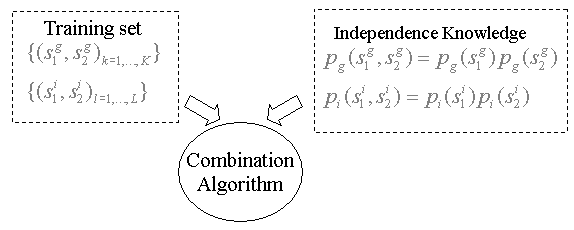Utilizing Independence of Classifiers
This project looks into rather unique property of biometric
matchers, matcher independence, and whether this property can be
effectively utilized in their combination. Note, that independence
assumption was sometimes previously applied in the combination of
non-independent classifiers or features (Naive Bayesian), resulting in
non-optimal combination. In this project we assume that
we already have optimal combination algorithm, and
want to investigate whether additional usage of independence knowledge
gives any additional improvement. The problem is really a machine
learning problem: given the same number of training samples, can we
reduce the learning error of the algorithm if independence knowledge is
used? The training set does not provide independence
knowledge; instead it should be communicated separately to the
combination algorithm.
The independence knowledge allows us to decompose score
densities into 1-dimensional components. Thus, instead of training
M-dimensional densities, we can train 1-dimensional densities, and
multiply them afterwards. The question is whether such approach have
any benefits.

Main results:
- We mathematically proved that the approximation of
multidimensional density by multiplying 1-dimensional density
approximations is superior to direct approximation of multidimensional
density.
- Experiments on artificial data show advantage of using
independence knowledge in likelihood ratio combination method for
verification systems
- Experiments on real data showed small improvement
